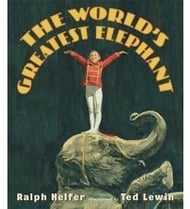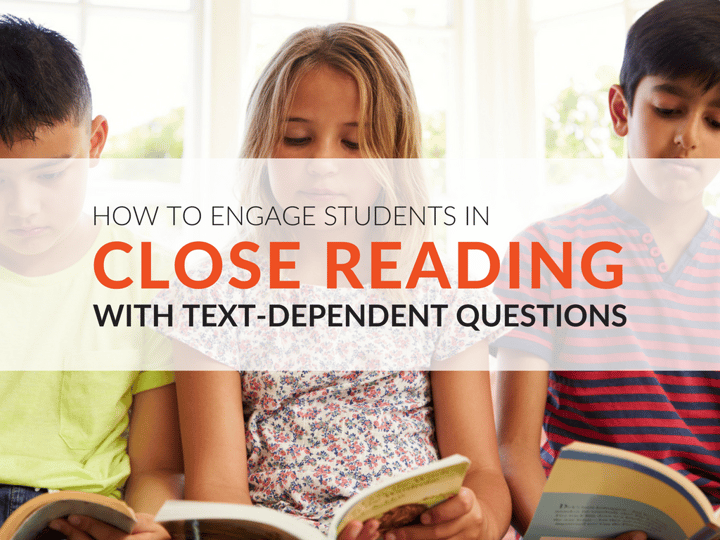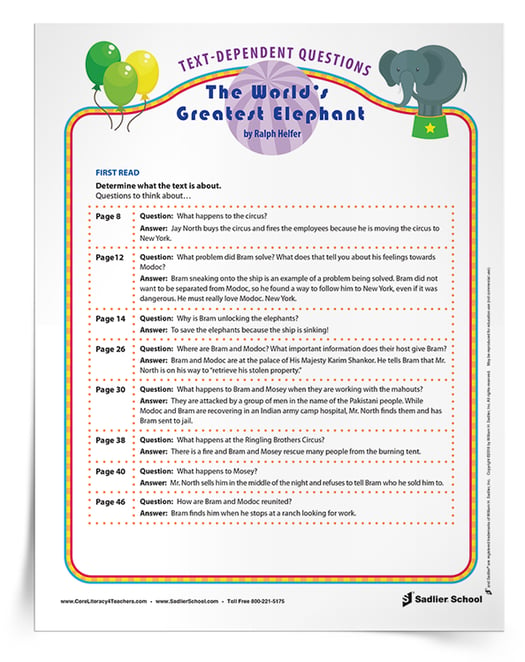April 2, 2018 ELA PD - Literacy, ELA K-5, ELA Focus - Close Reading, ELA Resources - Activities, Core Literacy
How to Use Text-Dependent Questions to Engage Students in Close Reading, Grades 2–5
By: Erin Lynch
In this article, you'll discover how to use text-dependent questions to engage students in close reading. I share text-dependent questions and passage I use from the book, Faithful Elephants: A True Story of Animals, People, and War by Yukio Tsuchiya. Then we'll discuss how to pair texts during close reading and text-dependent question analysis to work on comparing and contrasting with students. Get ready to dive into the details!
TEXT-DEPENDENT QUESTIONS FOR CLOSE READING LESSON PLANS
Close reading is when a reader analyzes the language and details of a text in order to develop a deeper understanding of the text’s meaning. Text-dependent questions for the students to analyze what the text means at deeper levels make up a critical component of close reading lessons. Text-dependent questions are also an important part of supporting students in developing a deeper level of comprehension about a text.
Text-dependent questions should be asked after each read!
This year, as I write my close reading lesson plans, I write them across three reads, with text-dependent questions to be answered with each read.
PURPOSE OF FIRST READ
Determine what the text is about. Read to find out:
- What are the key ideas or major points?
- Who are the characters?
- Where does the action take place?
- What happens?
PURPOSE OF SECOND READ
Focus on the language used by the author and on the structure of the text. As you read, make a note of answers to the following questions.
- How is the text organized? Chronologically? In a problem and solution structure? As cause and effect? With headings or bulleted lists?
- How does the author's use of figurative language give you a greater understanding of what is happening in the text?
- What words or phrases are repeated? How does the repetition add to the text's meaning?
- What is the author's purpose?
PURPOSE OF THIRD READ
Look for meaning by making inferences. Think about whether the text answers these questions:
- How can I connect any of the ideas in the text to another text I've read or something I've learned?
- What is the theme of the text?
- What larger point or message do the writer's ideas add up to
EXAMPLE OF TEXT-DEPENDENT QUESTIONS AND PASSAGES
 Faithful Elephants: A True Story of Animals, People, and War by Yukio Tsuchiya is the heartbreaking story of three zoo elephants’ struggle to survive after they were sentenced to death during WWII by the Japanese army.
Faithful Elephants: A True Story of Animals, People, and War by Yukio Tsuchiya is the heartbreaking story of three zoo elephants’ struggle to survive after they were sentenced to death during WWII by the Japanese army.
Here are examples of text-dependent questions and passages from Faithful Elephants: A True Story of Animals, People, and War by Yukio Tsuchiya.
Text Excerpts from Pages 1-7
PAGE 1 EXCERPT
The cherry blossoms are in full bloom at the Ueno Zoo. Their petals are falling in the soft breeze and sparkling in the sun. Beneath the cherry trees, crowds of people are pushing to enter the zoo on such a beautiful day.
PAGE 2 EXCERPT
Two elephants are outside performing their tricks for a lively audience. While blowing toy trumpets with their long trunks, the elephants walk along large wooden logs.
PAGE 3 EXCERPT
Not far from the cheerful square, there stands a tombstone. Not many notice this monument for the animals that have died at the Ueno Zoo. It is quiet and peaceful here, and the sun warms every corner.
One day, an employee of the zoo, while tenderly polishing the stone, told me a sad story of three elephants buried there.
PAGE 4 EXCERPT
“Today,” he said, “there are three elephants in this zoo. But years ago, we had three different elephants here. Their names were John, Tonky, and Wanly. At this time, Japan was at war. Gradually, the war had become more and more severe. Bombs were dropped on Tokyo every day and night, like falling rain.
PAGE 5 EXCERPT
“What would happen if bombs hit the zoo? If the cages were broken and dangerous animals escaped to run wild through the city, it would be terrible! Therefore, by command of the Army, all of the lions, tigers, leopards, bears, and big snakes were poisoned to death.
PAGE 6 EXCERPT
“By and by, it came time for the three elephants to be killed. They began with John. John loved potatoes, so the elephant keepers mixed poisoned potatoes with the good ones when it was time to feed him. John, however, was a very clever elephant. He ate the good potatoes, but each time he brought a poisoned potato to his mouth with his trunk, he threw it to the ground, kerplunk!
PAGE 7 EXCERPT
“‘As it seems there is no other way,’ the zoo keepers said, ‘we must inject poison directly into his body.’
“A large syringe, the kind used to give shots to horses, was prepared. But John’s skin was so tough that the big needles broke off with a loud snap, one after the other. When this did not work, the keepers reluctantly decided to starve him to death. Poor John died seventeen days later.’”
Text-Dependent Questions for Passages
FIRST READ
- Who is telling the story?
- Who is the story about?
- Why did the Japanese army command the zoo animals be killed?
SECOND READ
- On page 3, the author describes the zoo keeper as "tenderly polishing the stone." What does that tell you about him?
- On page 4, the zookeeper says the bombs being dropped on Tokyo day and night were "like falling rain." What does the author want you to know about the setting?
- What do you think is the author's purpose for writing this book?
THIRD READ
- On page 7, we learn the zookeepers "reluctantly" starved John to death. Make an inference about the zookeepers.
- What themes are beginning to emerge in the text?
- Are you making any connections to texts you have read
PAIRING CLOSE READING TEXTS TO COMPARE & CONTRAST
 If you have never used Faithful Elephants: A True Story of Animals, People, and War by Yukio Tsuchiya, you should read it with your students this year! The story is so powerful and touching that it elicits the most interesting discussions amongst students. It is a great text for close reading because the storyline, the author's craft and the message behind the book are so intriguing that students remain very engaged throughout multiple reads.
If you have never used Faithful Elephants: A True Story of Animals, People, and War by Yukio Tsuchiya, you should read it with your students this year! The story is so powerful and touching that it elicits the most interesting discussions amongst students. It is a great text for close reading because the storyline, the author's craft and the message behind the book are so intriguing that students remain very engaged throughout multiple reads.
I often like to pair texts whenever possible to be able to work on comparing and contrasting with my students. Faithful Elephants: A True Story of Animals, People, and War by Yukio Tsuchiya is such a sad story about three elephants that I pair it with an uplifting story about an elephant. The text I pair Faithful Elephants with is The World's Greatest Elephant by Ralph Helfer.
Text-Dependent Questions Worksheet
Available for download are text-dependent questions to use with The World's Greatest Elephant by Ralph Helfer. This book is always a student favorite every year. Educators can use this download to close read The World's Greatest Elephant with students and help them gain a deeper understanding of the text.






